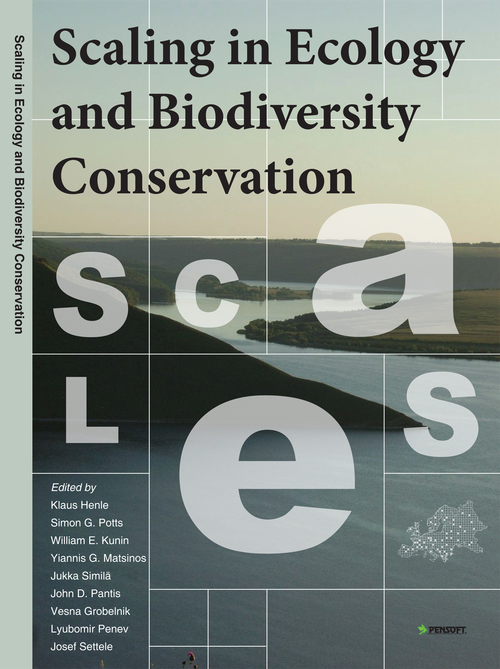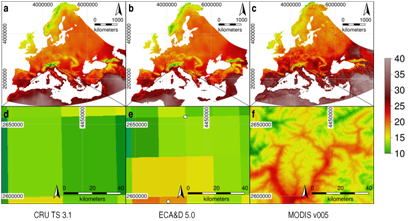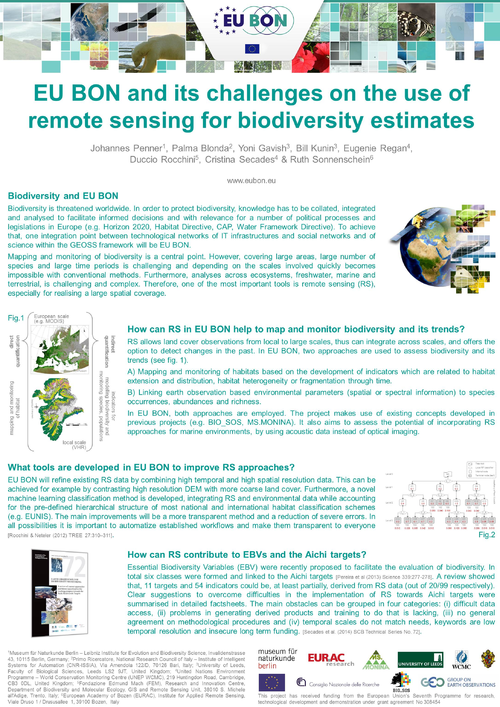ECOSCOPE (Network of Biodiversity Research Observatories) associates the SINP (Information System on Nature and Landscapes) to a shared event that will focus on the complementarity between "research - expertise" on biodiversity through the emerging concept of "Essential Biodiversity Variables" (EBVs).
The seminar, scheduled for Monday, November 3, 2014 in Paris, is open to scientists, observatories’ managers and their teams, and to all who are involved in the study of the state and dynamics of biodiversity for research and expertise.
The aims of this seminar are to increase awareness and understanding of EBVs, their interest for observatories (visibility, synergies) to benefit to observatories’ scientific managers and data users. It is also to define how this concept can be implemented at national scale, in connection with international initiatives.
Programme will be available in available in September, for registration: follow the link !
The 3rd International Conference on Biodiversity and the UN Millennium Development Goals will take place between October 29-31, 2014 in Aix-en-Provence, France. under the tematic title "Biodiversity and Food Security – From Trade-offs to Synergies".
This conference is the third in a series, organized by the French CNRS Institut Ecologie et Environnement (InEE) and the German Leibniz Association (WGL). The conference is based on invited keynotes and contributed posters for any of the topics relevant to the conference theme. Keynote speakers are now confirmed, including Professor José Sarukhán, UNAM, México, and Professor Jacqueline McGlade, UNEP, Nairobi.
Across scales from genes to species, landscapes and biomes, biodiversity is an important resource for humanity. It is the key for a broad range of services provided by ecosystems. Biodiversity helps regulate the nutrient cycle, water (e.g. floods) and mitigates impacts of climate change. Biodiversity is also of direct importance for human well-being and for cultural and other values including recreation. The provisioning of clean water and diverse food supply makes it vital for all people.
Biodiversity at all levels, including the diversity of genes, species and ecosystems, is lost at alarming rates. Critical factors for these trends are habitat destruction, global warming and the uncontrolled spread of alien species. Pollution, nitrogen deposition and shifts in precipitation further affect biodiversity.
Food security faces significant challenges due to population growth, poverty, globalization, climate change and other factors. Supplying healthy food to all citizens is crucial for global development - to reach it, not only food production but also equitable access to food for all people must be improved substantially. Biodiversity loss and global food security are hence two major challenges of our time.
Linking biodiversity and food security issues from a research perspective, and seeking synergies between them is likely to generate multiple benefits for social, ecological and economic development.
Follow this link to register, submit your abstract and secure your hotel reservations.
 Results are also presented in an easy to use interactive SCALETOOL, specifically developed for the needs of policy and decision-makers. The tool also provides access to a range of biodiversity data and driver maps compiled or created in the project.
Results are also presented in an easy to use interactive SCALETOOL, specifically developed for the needs of policy and decision-makers. The tool also provides access to a range of biodiversity data and driver maps compiled or created in the project.IPBES was established in April 2012, as an independent intergovernmental body open to all member countries of the United Nations. The members are committed to building IPBES as the leading intergovernmental body for assessing the state of the planet's biodiversity, its ecosystems and the essential services they provide to society.
The 8th GEO European Projects Workshop (GEPW-8) took place in Athens, Greece, on 12 and 13 June, hosted by the Greek GEO Office - National Observatory of Athens and co-organized by the Mariolopoulos-Kanaginis Foundation for the Environmental Sciences.
The event was intended to bring all those interested in and actively contributing to the Global Earth Observations System of Systems (GEOSS) from all over Europe together, in order to present their work and discuss how Europe can contribute to this international effort, especially in the wake of the launch of the new EU Framework Programme for Research, Horizon 2020, and renewal of the mandate of GEO for another 10 years through the endorsement of the 2014 Geneva Declaration.
Oral presentations, a book of abstracts and the photos from the event are now uploaded and available for download on the events website.
Funded by the "Severo Ochoa" Excellence Program awarded by the Spanish Ministry of Economy and Competitiveness, the Doñana Biological Station (www.ebd.csic.es) seeks a Postdoctoral fellow for two-years with the aim to conduct research in the field of Biological Invasions.
EBD-CSIC is interested to examine the multifaceted causes and consequences of biological invasions, a key component of global change. The ultimate goal is to improve our knowledge of the factors that influence the success and impacts of invasions by plants and vertebrates. For this purpose, we investigate species traits conferring invasive potential, the vulnerability of ecosystems to be invaded, and the sensitivity of native biodiversity to invasions under different environmental conditions and scenarios of global change.
Deadline for interested applicants: 17th June-17th July, 2014
Please see attached file for more details (download, pdf)
Philosophy of Biological Systematics (8-12 September 2014)
Course venue: Royal Belgian Institute of Natural Sciences, Brussels, Belgium
Training provider: Dr. Kirk Fitzhugh, Natural History Museum of Los Angeles County, U.S.A.
Registration deadline is being extended untilFriday 20 June 2014
Course venue: Muséum national d'Histoire naturelle, Paris, Franc
Training provider: Prof. Alain Dubois, Muséum national d'Histoire naturelle, Paris
Registration deadline is being extended untilFriday 20 June 2014
Botanical Nomenclature training course (26-30 January 2015)
Course venue: Royal Botanic Gardens Kew, U.K.
Training provider: Katherine Challis, Royal Botanic Gardens, Kew
Registration deadline: 10 October 2014
To read more about the courses and to register, visit the official DEST webpage: http://www.taxonomytraining.eu/content/modern-taxonomy-course-programme-2013-2014
Four papers on species traits have been recently published in ZooKeys, Ecology and Ecology, Evolution and the Biodiversity Data Journal respectivelly covering data on the butterflies in Europe, birds and mammals of the world, the terrestrial mammals of the world and marine polychaetes.
Schweiger O, Harpke A, Wiemers M, Settele J (2014) CLIMBER: Climatic niche characteristics of the butterflies in Europe. ZooKeys 367: 65–84. doi: 10.3897/zookeys.367.6185 Resource ID: GBIF key: http://www.gbif.org/dataset/e2bcea8c-dfea-475e-a4ae-af282b4ea1c5
Hamish Wilman, Jonathan Belmaker, Jennifer Simpson, Carolina de la Rosa, Marcelo M. Rivadeneira, and Walter Jetz. 2014. EltonTraits 1.0: Species-level foraging attributes of the world's birds and mammals. Ecology 95:2027. http://dx.doi.org/10.1890/13-1917.1
Kissling, W. D., Dalby, L., Fløjgaard, C., Lenoir, J., Sandel, B., Sandom, C., Trøjelsgaard, K. and Svenning, J.-C. (2014), Establishing macroecological trait datasets: digitalization, extrapolation, and validation of diet preferences in terrestrial mammals worldwide. Ecology and Evolution. doi: 10.1002/ece3.1136
Faulwetter S, Markantonatou V, Pavloudi C, Papageorgiou N, Keklikoglou K, Chatzinikolaou E, Pafilis E, Chatzigeorgiou G, Vasileiadou K, Dailianis T, Fanini L, Koulouri P, Arvanitidis C (2014) Polytraits: A database on biological traits of marine polychaetes. Biodiversity Data Journal 2: e1024. DOI: 10.3897/BDJ.2.e1024
The June 2014 updates of FishBase and SeaLifeBase are now available online!
FishBase: www.fishbase.us; www.fishbase.ca
FishBase stats to date: 32800 Species, 303100 Common names, 53900 Pictures,
50200 References, 2110 Collaborators, 700000 Visits/Month
SeaLifeBase: www.sealifebase.ca

Target group: programmers, developers and system engineers. The workshop is open to anybody who might be interested to learn more about the DINA-system.
Preliminary agenda:
- Presentations from all DINA-partners
- APIs, service oriented architecture and road map for distributed development, guidelines and principles on how to build a module and join the DINA-system
- Case studies
- Delivery options: creating installations from hosted environment, virtual machines down to code.
A detailed program will be available by the end of August 2014.
There will be a SETF-meeting for DINA consortium members on the 15th of September.
Welcome to register for the workshop here:
DINA - Technical Workshop 16-18 September, Stockholm
The workshop is an activity within WP 1 Task 1.4

Temperature is a main driver for most ecological processes, and temperature time series provide key environmental indicators for various applications and research fields. High spatial and temporal resolutions are crucial for detailed analyses in various fields of research. A disadvantage of temperature data obtained by satellites is the occurrence of gaps that must be reconstructed. Here, we present a new method to reconstruct high-resolution land surface temperature (LST) time series at the continental scale gaining 250-m spatial resolution and four daily values per pixel. Our method constitutes a unique new combination of weighted temporal averaging with statistical modeling and spatial interpolation. This newly developed reconstruction method has been applied to greater Europe, resulting in complete daily coverage for eleven years. To our knowledge, this new reconstructed LST time series exceeds the level of detail of comparable reconstructed LST datasets by several orders of magnitude. Studies on emerging diseases, parasite risk assessment and temperature anomalies can now be performed on the continental scale, maintaining high spatial and temporal detail. We illustrate a series of applications in this paper. Our dataset is available online for download as time aggregated derivatives for direct usage in GIS-based applications (Reconstructed MODIS Land Surface Temperature Dataset - http://gis.cri.fmach.it/eurolst/).
Source: Metz M, Rocchini D, Neteler M. (2014) Surface Temperatures at the Continental Scale: Tracking Changes with Remote Sensing at Unprecedented Detail.Remote Sensing 6(5): 3822-3840. doi: 10.3390/rs6053822


Europe's brown bear, wolf, wolverine, lynx – at least one of these species can now be found in 21 EU Member States. After a lengthy period of decline their numbers are growing once more, but coexistence with man can be problematic. In an effort to solve the social and economic problems that sometimes result from this new expansion, the European Commission has launched a platform where farmers, conservationists, hunters, landowners and scientists can exchange ideas and best practices on sharing the same land with large carnivores.
The EU Platform on Coexistence between People and Large Carnivores will support constructive dialogue between key stakeholder organisations at the European level. Launching the platform, EU Environment Commissioner Janez Potočnik said: "We need to treat our natural neighbours with respect – but we also need to heed the concerns of those whose lives are genuinely affected by their close proximity. My warm congratulations to the organisations that have worked together to set up this important platform, which represents a major step forward in efforts to address the issue of peaceful coexistence."
The European Union is home to five species of large carnivores. All suffered dramatic declines in numbers and distribution as a consequence of human activity, but increasing protection and public awareness about their vital role in healthy ecosystems have caused many populations to stabilize or increase, and to return to areas from which they had been absent for decades or even centuries.
While this recovery is seen by some as a great conservation success, it has not been without its opponents. The issue involves a diversity of stakeholders such as hunters, foresters, livestock producers, reindeer herders, landowners, rural communities, conservation organizations and the wider public. These groups are influenced by and perceive large carnivores in different ways, and in some cases these differences can be a source of conflict. The platform will facilitate exchanges of knowledge and promote ways and means to minimize, and wherever possible, find equitable solutions to these conflicts.
The platform launched today follows a number of efforts to understand the conflicts between stakeholders over large carnivores, the results of which were set out in workshops conclusions and in a report.
Next steps
The Platform will hold its first working session immediately following the official launch today, on 10 June. It will adopt terms of reference and a work plan. The Platform will hold one annual meeting and organize additional workshops on selected topics. It will be supported by a web-based resource centre that will serve as the main tool to disseminate information on the activities of the platform, identify good practices in the form of documents or a manual, act as a gateway to the portals of the member organisations, and host media resources such as press kits for journalists.
For more information:
Original press release: http://europa.eu/rapid/press-release_IP-14-648_en.htm
Visit the large carnivore website of DG Environment at http://ec.europa.eu/environment/nature/conservation/species/carnivores/index_en.htm
http://ec.europa.eu/environment/nature/index_en.htm
The signing ceremony and moderated panel discussion is streamed (https://new.livestream.com/corlive1/events/2977474/embed) on the internet (also see http://ec.europa.eu/environment/nature/conservation/species/carnivores/index_en.htm)
 The first day started with the welcoming notes by the ZSL and the news that a new journal, which is especially created for the interplay between remote sensing and conservation, will be published soon. Woody Turner (NASA) gave a fabulous keynote with examples of current state of the art studies, such as using drones and off the shelf cameras to get cheap custom designed aerial images, the impressive combination of radar data with hyperspectral bands which lead to a 3D image of forest biodiversity and the emerging use of bioacoustics to monitor biodiversity. Nathalie Pettorelli (ZSL) gave an introduction into NDVI (Normalized Differenced Vegetation Index) and an overview of its usefulness for conservation. Martin Wegmann (University of Würzburg, DLR) showed the usefulness of a variety of fragmentation indices. Thomas Esch (DLR) showed the current status of the upcoming global urban footprint. Diane Davies (NASA) listed and compared a number of sources which monitored fires on a regional and global scale. Frank Muller-Karger (University of South Florida) elaborated on his enormous efforts to create global "seascapes" comparable to landscapes or ecoregions and his ultimate goal, a global marine biodiversity observation network (mbon). Temilola Fatoyinbo (NASA) explained the efforts towards a comprehensive global assessment of mangroves. Peter Reinartz (DLR) tested whether space born animal tracking is possible, and it will be.
The first day started with the welcoming notes by the ZSL and the news that a new journal, which is especially created for the interplay between remote sensing and conservation, will be published soon. Woody Turner (NASA) gave a fabulous keynote with examples of current state of the art studies, such as using drones and off the shelf cameras to get cheap custom designed aerial images, the impressive combination of radar data with hyperspectral bands which lead to a 3D image of forest biodiversity and the emerging use of bioacoustics to monitor biodiversity. Nathalie Pettorelli (ZSL) gave an introduction into NDVI (Normalized Differenced Vegetation Index) and an overview of its usefulness for conservation. Martin Wegmann (University of Würzburg, DLR) showed the usefulness of a variety of fragmentation indices. Thomas Esch (DLR) showed the current status of the upcoming global urban footprint. Diane Davies (NASA) listed and compared a number of sources which monitored fires on a regional and global scale. Frank Muller-Karger (University of South Florida) elaborated on his enormous efforts to create global "seascapes" comparable to landscapes or ecoregions and his ultimate goal, a global marine biodiversity observation network (mbon). Temilola Fatoyinbo (NASA) explained the efforts towards a comprehensive global assessment of mangroves. Peter Reinartz (DLR) tested whether space born animal tracking is possible, and it will be.




 RSS news
RSS news













 Interesting projects and articles
Interesting projects and articles
